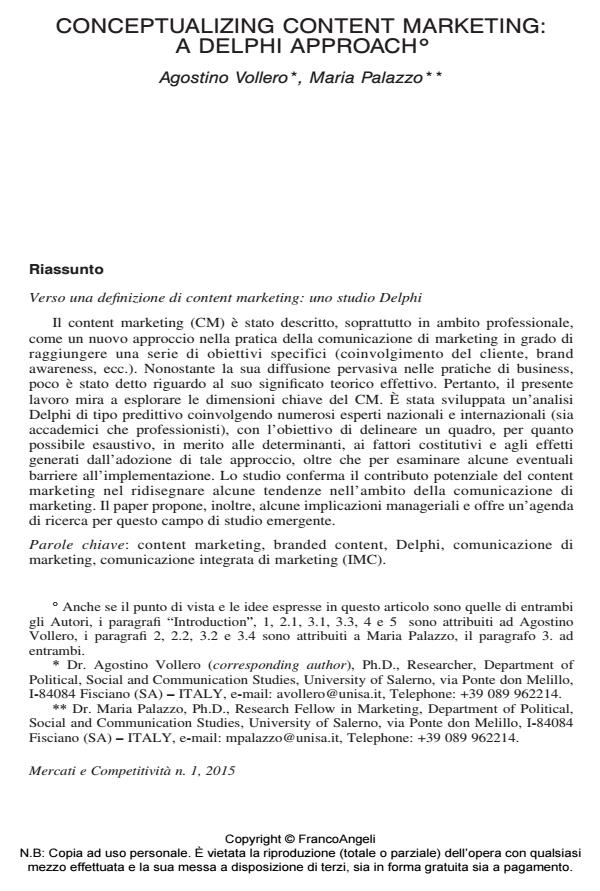Conceptualizing content marketing: a delphi approach
Journal title MERCATI E COMPETITIVITÀ
Author/s Agostino Vollero, Maria Palazzo
Publishing Year 2015 Issue 2015/1
Language Italian Pages 20 P. 25-44 File size 102 KB
DOI 10.3280/MC2015-001003
DOI is like a bar code for intellectual property: to have more infomation
click here
Below, you can see the article first page
If you want to buy this article in PDF format, you can do it, following the instructions to buy download credits

FrancoAngeli is member of Publishers International Linking Association, Inc (PILA), a not-for-profit association which run the CrossRef service enabling links to and from online scholarly content.
Content marketing (CM) has been described, especially by practitioners, as a new approach in the practice of marketing communications, suitable to reach a variety of goals, such as customer engagement and brand awareness. Despite its pervasive diffusion in the business community, very little has been said about its theoretical robustness as well as its actual significance for academic research. Thus, the present paper aims at exploring the key dimensions of the construct. A Delphi-type predictive survey of several international experts (both academics and practitioners) has been devised with the aim of producing one comprehensive view of content marketing, discussing the main determinants, definitions, issues, benefits and barriers surrounding the concept. The study partially confirms the potential contribution of “content marketing” in reshaping emerging research trends in marketing communications. The paper details some managerial implications of the construct’s definition and develops a preliminary research agenda for this field of study.
Keywords: Content marketing, branded content, Delphi, marketing communications, integrated marketing communications (IMC).
- The importance of content marketing for achieving customer brand engagement Nermana Mahmić-Muhić, Almir Klico, in BH Ekonomski forum /2022 pp.131
DOI: 10.5937/bhekofor2201131M - Identifying consumer-based digital content marketing consumption motives: a qualitative study Shelleka Gupta, Ronnie Dutt, in Journal of Advances in Management Research /2024 pp.584
DOI: 10.1108/JAMR-08-2023-0218 - The Emerald Handbook of Multi-Stakeholder Communication Rahime Zaman Fashami, Manijeh Haghighinasab, Nader Seyyedamiri, Pari Ahadi, pp.281 (ISBN:978-1-80071-898-2)
- Don't forget about customer magazines: the effects of reading experiences on customer magazine effectiveness Clemens Koob, in Frontiers in Communication 1195620/2023
DOI: 10.3389/fcomm.2023.1195620
Agostino Vollero, Maria Palazzo, Conceptualizing content marketing: a delphi approach in "MERCATI E COMPETITIVITÀ" 1/2015, pp 25-44, DOI: 10.3280/MC2015-001003